|
Report from
Europe
Healthy growth in EU tropical wood imports during
2015
European imports of tropical timber showed healthy
growth between January and November of last year, with
total value rising 15% to euro 2.059bn (2014: euro
1.788bn).
The first quarter of 2015 was particularly strong, with an
increase of 20.5% over the still relatively weak first three
months of 2014. After a dip in summer 2015, imports
picked up again between September and November last
year (Chart 1).
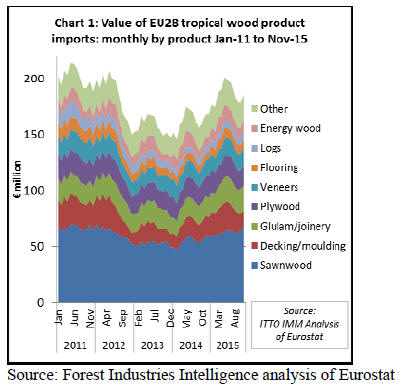
Sharp increase in EU imports of tropical LVL,
mouldings and flooring
European imports of all major tropical wood products
increased in the first eleven months of 2015. There was
particularly strong growth in the value of EU imports of
tropical joinery products (mainly LVL) which increased
27.2% to euro 237.2 million, together with
mouldings/decking which increased 25.3% to euro 228.1
million.
There was also good recovery in the value of sawn wood
imports, which were up 14.3% at euro 692.3 million.
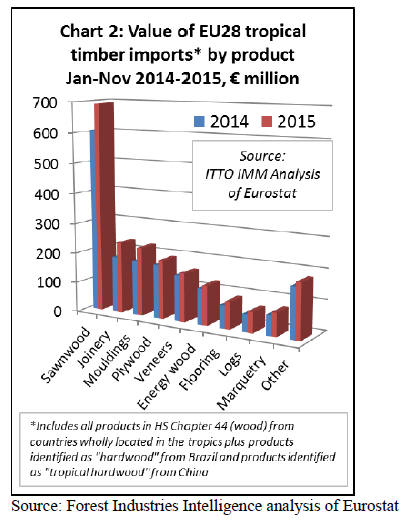
After many years of consistent decline, there was even a
minor rebound in EU imports of tropical logs, up 18%
from a small base to euro 67.4 million. A similar increase
(+18.7% to euro 89.7 million) was recorded in imports of
tropical wood flooring.
However imports of tropical plywood (+9% to euro
194m), veneers (+6% to euro 162m) and energy wood
(+9% to euro 130m) only increased by single-figure
percentages in each case (Chart 2).
Broader-based recovery in the EU tropical wood
imports
While the growth that occurred in EU tropical wood
product imports during 2014 was due mainly to rising
consumption in the UK, the 2015 recovery was much
more broadly based.
In the first eleven months of 2015, there was double¨Cdigit
growth in tropical wood import value into Belgium (+16%
to euro 325m), Denmark (+25% to euro 53m), France
(+14% to euro 301m), Germany (+12% to euro 258m), the
Netherlands (+22% to euro 298m) and the UK (+12% to
euro 348m).
Among crisis-ridden southern European countries,
Portugal fared very well, with a sharp 67.7% increase in
imports to euro 62m during the first 11 months of 2015.
The rise in imports into Italy (+4% to euro 177m) and
Spain (+4% to euro 92m) was more moderate but heading
in the right direction. Even Greece recovered ground last
year with import growth of 16% to euro 36m (Chart 3).
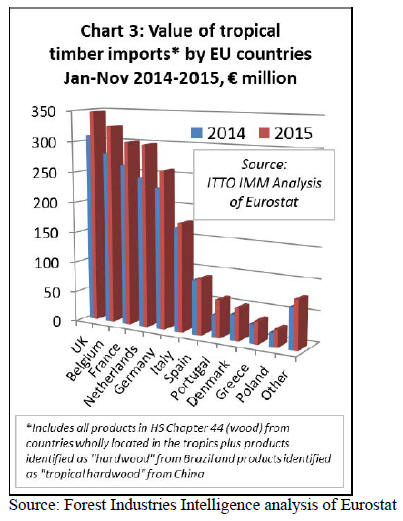
The rise in the euro value of EU imports is partly due to
exchange rate movements. The average euro/US$
exchange rate was 1.11 in 2015 compared to 1.32 in 2014
implying that inflated prices for many imported wood
products last year.
However closer analysis shows significant growth in the
volume as well as value of tropical wood imports in most
product sectors.
EU tropical sawn imports exceed 1 million cu.m in
2015
EU imports of tropical sawn wood in the first 11 months
of 2015 were 992,000 cu.m, 9% more than the same
period the previous year. It¡¯s therefore almost certain that
EU imports for the full year will exceed 1 million cu.m for
the first time since 2012.
While an encouraging landmark, this is still well down on
levels prevailing before the crises when annual imports
exceeded 2 million per year.
Cameroon, from which the EU imported 300,800 cu.m in
the first eleven months of last year, an increase by 11%,
cemented its leading position as the EU¡¯s most important
supplier of tropical sawn wood.
The four next largest suppliers all registered lower growth
rates than Cameroon: imports increased by 7% from
Malaysia to 225,700 cu.m, by 9% from Brazil to 115,700
cu.m, by 8% from Gabon to 87,200 cu.m, and by 8% from
Ivory Coast to 75,800 cu.m.
However there was an above average in imports from
several smaller suppliers including Congo (+15% to
50,200 cu.m.), Ghana (+14% to 24,700 cu.m) and
Indonesia (+12% to 20,400 cu.m ) (Chart 4).
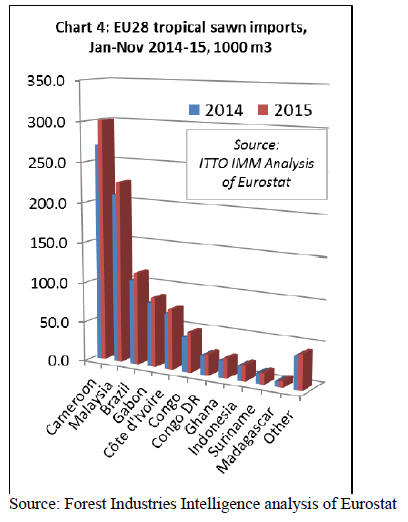
Consistent growth in tropical sawn imports across the
EU
All the largest EU markets imported more tropical sawn
wood in the first eleven months of 2015 compared to the
previous year. Growth rates were quite evenly spread,
ranging between +7% and +12% (Chart 5).
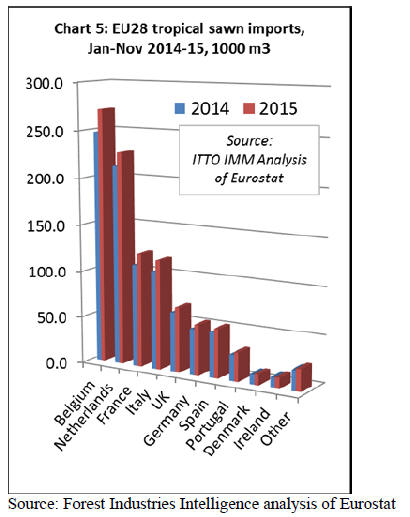
Belgium was the largest single importer of tropical sawn
wood in 2015, with volume rising 10% in the first 11
months of the year to 271,000 cu.m . Much of this volume
is destined for neighbouring EU countries rather than
consumed in Belgium. Imports into the Netherlands were
also on the rise last year, up 7% to 227,400 cu.m.
This is a reflection both of increased domestic
construction activity in the Netherlands and of the
country¡¯s important role as an entry-point for hardwoods
distributed throughout the continent.
There was 12% growth in imports by France and Italy, to
122,300 cu.m and 117,400 cu.m respectively, particularly
encouraging as these countries have been very slow to
recover from the market downturn.
Meanwhile the positive trend in imports by the UK and
Germany continued, with a 10% increase in each case to
69,400 cu.m and 53,900 cu.m respectively. Imports into
Spain and Portugal, too, experienced healthy growth rates:
Spain¡¯s imports rose by 9% to 52,800 cu.m and Portugal¡¯s
by 10% to 31,300 cu.m .
Log imports on the way up again
European imports of tropical logs gained ground in the
first eleven months of last year, rising 14% to 158,954
cu.m .
Imports were almost exclusively sourced from African
countries although Suriname is now established as a small
but consistent supplier of logs to the EU, particularly of
denser and FSC-certified wood for sea defence works and
similar heavy-duty applications.
EU imports of tropical logs increased sharply from Congo
(up 18% to 38,136 cu.m), Democratic Republic of the
Congo (up 17% to 35,277 cu.m), Cameroon (up 9% to
34,936 cu.m), and Central African Republic (up 16% to
18,471 cu.m).
There was also a resumption in log imports from Liberia,
which jumped 41% to 10,094 cu.m in the first 11 months
of last year (Chart 6).
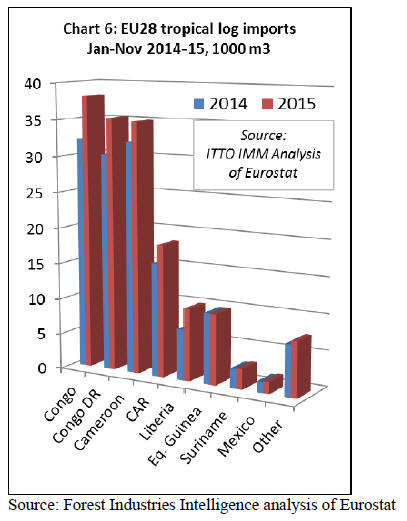
Much of the growth in EU imports of tropical logs was
concentrated in Belgium and Portugal, the second and
third most important EU importers after France, which at
63,943 cu.m only imported 1% more than in 2014.
Belgium imported 28,979 cu.m between January and
November 2015, more than twice as much as the year
before (+122.6%).
Portugal shows a similar trend: at 28,226 cu.m the country
imported 57.9% more than in 2014. And Italy, too,
boosted its import volume by 49% to 15,583 cu.m .
Imports of decking/moulding rise rising prices
EU imports of ¡°continuously shaped¡± wood (HS code
4409), which includes both decking products and interior
decorative products like moulded skirting and beading,
increased 7% to 199,000 cu.m in 2015.
EU imports of tropical decking and moulding products
increased from all the leading suppliers including
Indonesia (+6% to 85,800 cu.m ), Brazil, (+7% to 69,600
cu.m ) and Malaysia (+10% to 17,500 cu.m ) (Chart 7).
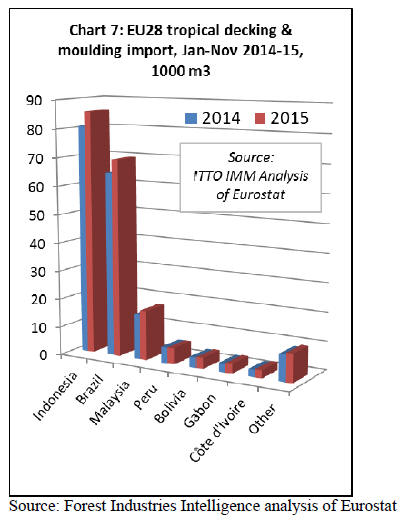
The 7% rise in the volume of EU imports of tropical
moulding/decking in the first 11 months of 2015 is
considerably less than the 25% gain in import value. This
is because most is sourced from South-East Asia and
Brazil where suppliers invoice in US$ dollars (in contrast
to African suppliers who generally invoice in euros).
It is also clear that the steep fall in container freight rates
experienced during the course of 2015 was insufficient to
offset the rise in US dollar-based prices. Nevertheless it is
encouraging that European import volume showed some
growth despite rising prices.
EU recovery ¡°at a moderate pace and amid risks¡±
It remains unclear whether these encouraging signs will
turn into a lasting growth trend. The German IFO
Institute¡¯s most recent Eurozone Economic Outlook
suggests that European economic recovery is likely to
continue ¡°at a moderate pace and amid risks¡±.
IFO estimates that real GDP in the euro-zone was 1.5% in
2015 and that growth will continue by 0.4% in both the
first and second quarter of 2016. Private consumption is
identified as the main driver behind the upturn stimulated
by a renewed drop in oil prices.
There is also expected to be a significant stimulus from
fiscal and social policy, particularly in Germany, not least
due to far higher government expenditure on consumption
and transfers related to the influx of refugees. Construction
investment is also expected to grow sharply in Germany
over the forecasting period.
According to IFO, main risks facing the European
economy are unrest in the Middle East, which could yet
lead to a surge in oil prices.
Moreover, the structural transformation of the Chinese
economy involves risks for Europe as well, as it could lead
to capital outflows from the emerging countries. ¡°This, in
turn, may cause strong financial market turbulence or even
exchange rate crises¡±, risks to which the euro-zone has
proven particularly vulnerable.
|